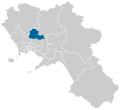| Campania 2 | |
|---|---|
| Chamber of Deputies Electoral constituency | |
 | |
| Region | Campania |
| Electorate | 2,131,555 (2022) [1] 2,158,084 (2018) [2] |
| Major settlements | Avellino, Benevento, Caserta, Salerno |
| Current constituency | |
| Created | 1993 |
| Seats | 18 |
| Members | |
Campania 2 is one of the 29 constituencies (Italian : circoscrizioni) represented in the Chamber of Deputies, the lower house of the Italian parliament. [3] The constituency currently elects 18 deputies. Its boundaries correspond to those of the provinces of Avellino, Benevento, Caserta and Salerno, within the Campania region. The electoral system uses a parallel voting system, which act as a mixed system, with 3⁄8 of seats allocated using a first-past-the-post electoral system and 5⁄8 using a proportional method, with one round of voting. [4]
Contents
The constituency was first established by the Mattarella law on 4 August 1993 and later confirmed by the Calderoli law on 21 December 2005 and by the Rosato law on 3 November 2017. The current borders of the districts were created as a result of the 2020 Italian Constitutional Referendum.



















